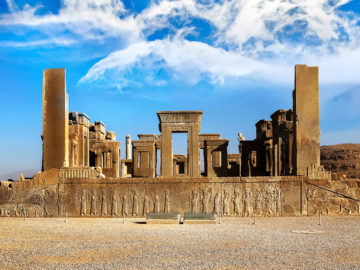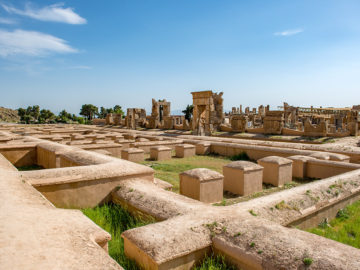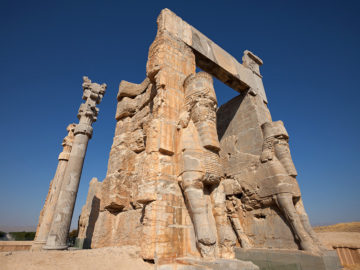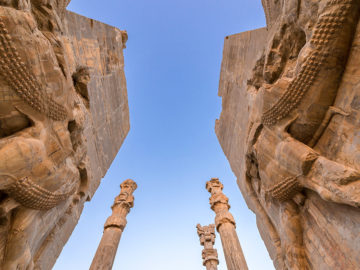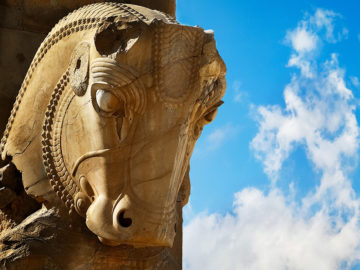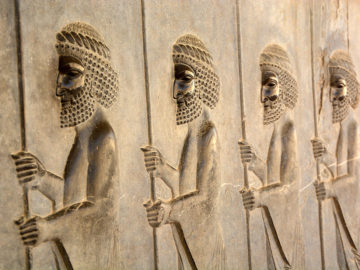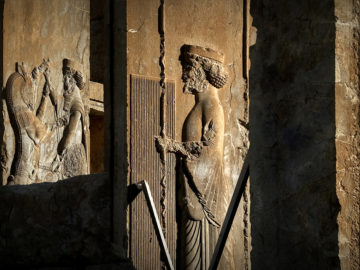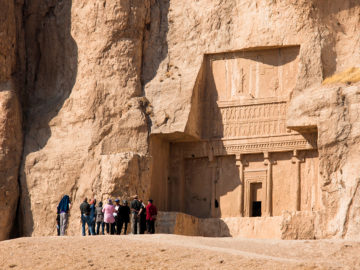
Persepolis (derived from Greek Pérsēs and pólis meaning the Persian city) or Takht-e Jamshid (literally meaning Throne of Jamshid – an Iranian mythological king) is the remains of Achaemenid (550 – 330 BCE) palace that Darius I, known as Darius the Great (522 – 486 BCE) began its construction in 518 BC after creating a vast terrace on the foot of Rahmat (Mercy) mountain. The buildings on the platform occupied an area of about 135,000 km2; the construction of the palaces and terraces began under the command of Darius I, and were continued in the era of Xerxes (496 – 465 BCE), Artaxerxes I (465 – 424 BCE), and Artaxerxes III (359 – 338 BCE). After the invasion of the Alexander of Macedon in 334 BC towards the east, Iranian forces were defeated, the Achaemenid dynasty was overturned, and Persepolis was destroyed.
The goal of Darius was not to create an administrative and/or political center, but a center for Iranian festivity and ceremonials. Some palaces on the terrace were residences for the imperial family and some were allocated to reception and formal greetings.
Persepolitan architecture is distinguished for its use of the quadrilateral spaces and Persian columns, construction of buildings on the terrace, application of wooden ceilings, cut and carved stones, column bases, and capitals, designing portals, and utilization of glazed tiles in interior spaces. It is interesting to know that no mortar is used in the construction of Persepolis and metal clips are employed to join stones together.

Persepolis, Gate of all nations – Marvdasht, Fars Province, Iran
Columns are a distinctive feature of Persepolis. Researchers believe that the combination and integration of various artistic practices including Greek, Egypt, Asia Minor, Mesopotamia, and in particular local style in the construction of Persepolis had led to the creation of columns with distinctive capitals that cannot be found in any other cultures. The height of some columns reaches up to 20 meters with capitals of zoomorphic and legendary creatures.
The main buildings at Persepolis include the Great Stairway, the Gate of All Nations, the Apadana, the Hall of Hundred Columns, the Tripylon Hall, the Hadish Palace, the Tachara, the Queen’s Palace, and the Imperial Treasury.

Plan of Perspolis
Infographic by Parinaz Ghashghaie
The Great Stairway, the Gate of All Nations
The entrance to the palace is located northwest of the yard and is accessible by a double-reversed staircase. Each staircase includes 111 stairs of 6.7 meters long, 10 cm height, and 38 cm wide. By climbing the stairs, the gate of all nations with a pair of lamassus (guardian winged-bulls with the heads of bearded men) show off. A trilingual inscription (in Elamite, Old Persian, and Babylonian) in the name of Xerxes is carved above each doorway jamb praising Ahura Mazda, the creator and sole God of Zoroastrianism, and introducing Xerxes and the magnificence of the building. The gate opened to a waiting room for representatives of different nations to precede their group for meeting Achaemenid kings. Archaeologists believed that this hall was completed at the time of Xerxes (496 – 465 BCE).

Apadana
By crossing the Gate of all Nations and the waiting hall, we arrive at the Apadana Hall that was the largest and most imposing palace of Persepolis; the audience palace of Darius I (522 – 486 BCE). It consisted of the main square hall of thirty-six columns, and three porticos each with twelve columns on the north, west and east sides. Its columns soared to a height of 20 meters and of the seventy-two columns once supporting the roof of the palace, only thirteen are still standing and the rest are fallen and broken.
Two grand Perspolitian symmetrical stairways were built in the north and east sides, nonetheless, the northern stairway demolished over time. Stone carvings decorate these monumental stairways, showing delegates of the 23 subject nations of the Persian Empire paying tribute to Darius I, giving him presents.
Hall of Hundred Columns
The Throne Hall is the second largest building of Persepolis. This 70×70 square meter hall was started by Xerxes I and completed by his son Artaxerxes I (465 – 424 BCE). Its eight stone doorways are decorated on the north and south with reliefs of throne scenes, and on the west and east with scenes depicting the king combating monsters. Researchers believe that the Throne Hall was used mainly for receptions representatives of all the subject nations of the empire.

Tripylon Hall
Council Hall or Central Hall is located in the southeastern corner of Apadana and the middle of other buildings. It is called Tripylon because it includes three grand gates. One of gates is sculptured with the representation of Darius I seated under the royal baldachin, Xerxes I, standing behind him, both on a monumental throne which is being carried into the hall upon the raised arms and hands of twenty-eight representatives of subject nations of the empire. The Central Hall opened to two columned porticos on the north and south. Reliefs of stairways suggest that the Throne Hall was used mainly for receptions for military commanders.
Hadish Palace
The Palace of Xerxes occupied the highest level of terrace and it was severely burned when Alexander of Macedon destroyed Persepolis as a revenge for his invasion of Athens. It had a thirty-six columned square hall, a twelve-columned portico on the north, a long balcony on the south, and some storage and guardrooms.
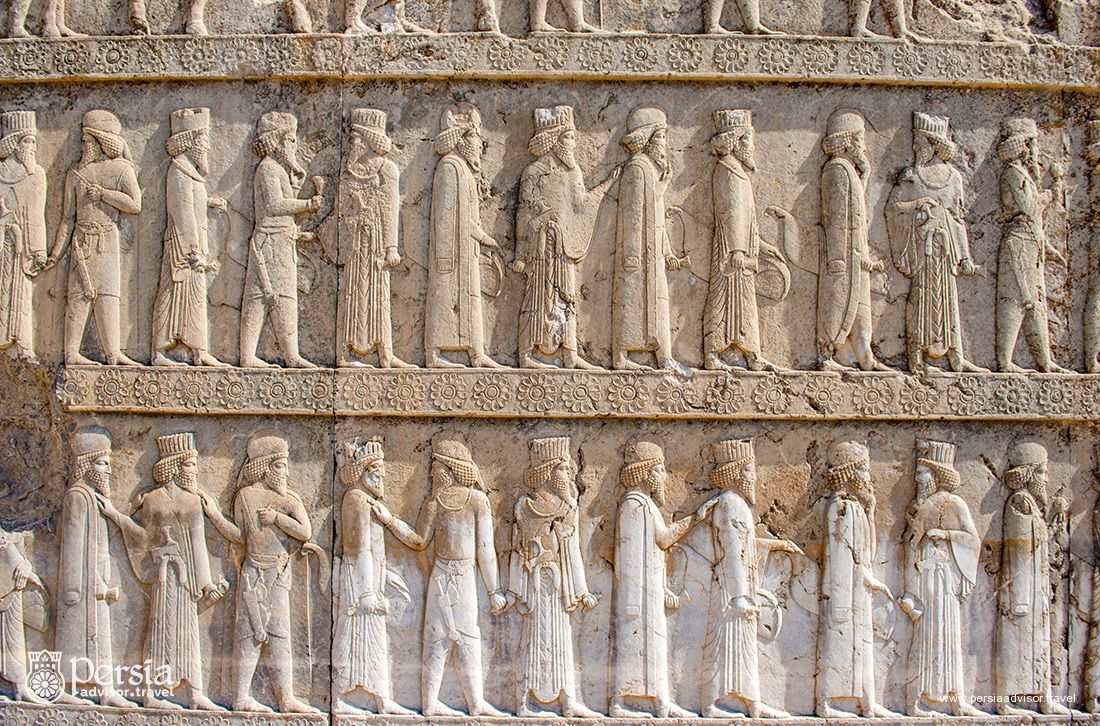
The Tachara
It is the oldest palace of Persepolis located in the south of the Apadana and some call it the Mirror Hall for its glossy rocks. Its main hall has a rectangular plan of 12 stone-made columns surrounded by smaller rooms and chambers. Inscriptions and Reliefs like the battle of “Lion and Bull” carved on the eastern and western entrance of the palace are critical features of the palace.
The Queen’s Palace (Museum)
The building of Persepolis museum was the palace for Achaemenid Queens and is one of the oldest structures work as a museum in Iran. It consists of the main hall with twelve columns, a portico with eight columns, several adjoining chambers, and a number of identical units on either sides of a long corridor. The collection of the Persepolis Museum consists of prehistoric, Achaemenid and Islamic eras.
The Treasury
The treasury of Persepolis is located in the east of the queen’s palace, and south of the Hall of a Hundred Columns consists of a huge yard in the eastern part surrounded by several columned porticos. An archive of 750 clay tablets from Darius I, Xerxes, and Artaxerxes I, carved with Elamite language explaining rules and regulations over labor workers and taskmasters as well as their wages paid from the treasury was notably found in the Treasury.
Palace of guardians, Tomb of Artaxerxes II (404 – 359 BCE), Tomb of Artaxerxes III (359 – 338 BCE), Unfinished Gate, Army road, Stone Well, Stone pool, Royal Hill, are among other places and structures of Persepolis.

